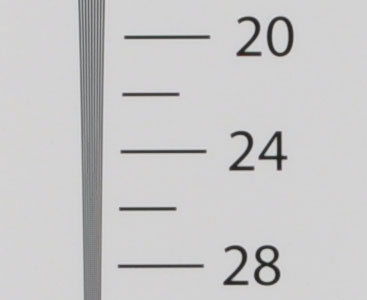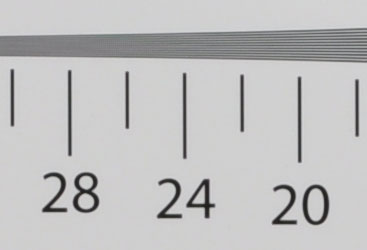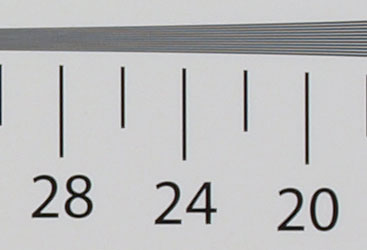Canon EOS 500D / Rebel T1i
-
-
Written by Gordon Laing
Studio resolution: Canon EOS 500D / Rebel T1i
Canon EOS 500D / T1i results : Real-life resolution / Studio resolution / Noise vs D5000 and E-620 / Noise vs 450D / XSi
Horizontal resolution using in-camera JPEGs
Canon EOS 500D / T1i with EF-S 18-55mm IS |
Canon EOS 50D with EF-S 18-200mm IS | |
 |  | |
2400 lpph, 18-55mm at 35mm, f8, 100 ISO |
2350 lpph, 18-200mm at 35mm, f8, 100 ISO | |
Nikon D5000 with Nikkor DX 18-55mm VR |
Olympus E-620 with Zuiko Digital 14-42mm | |
 |  | |
2250 lpph, 18-55mm at 35mm, f8, 100 ISO |
2350 lpph, 14-42mm at 25mm at f8, 100 ISO |
Vertical resolution using in-camera JPEGs
Canon EOS 500D / T1i with EF-S 18-55mm IS |
Canon EOS 50D with EF-S 18-200mm IS | |
 |  | |
2400 lpph, 18-55mm at 35mm, f8, 100 ISO |
2400 lpph, 18-200mm at 35mm, f8, 100 ISO | |
Nikon D5000 with Nikkor DX 18-55mm VR |
Olympus E-620 with Zuiko Digital 14-42mm | |
 |  | |
2250 lpph, 18-55mm at 35mm, f8, 100 ISO |
2350 lpph, 14-42mm at 25mm at f8, 100 ISO |
Canon EOS 500D / Rebel T1i Studio resolution: JPEG versus RAWWe photographed our test chart in the EOS 500D / T1i’s RAW plus Large Fine JPEG mode, allowing us to directly compare images created from exactly the same data. Below are crops taken from the original JPEG file alongside the RAW version, processed in Canon’s supplied Digital Photo Professional 3.6 software using the default settings (Sharpness of 3). The RAW version using DPP’s default settings avoids moiré and other resolving artefacts until higher frequencies, giving a boost in the figures to 2500 lpph; this comes close to matching the 2550 lpph we measured with the 50D, albeit when using a prime lens. So if you’d like to technically maximise the resolving power of the 500D / T1i, you should shoot in RAW, although as seen on the previous page, you may not notice much difference in real-life situations. Now let’s check out the camera’s performance at different sensitivities in our Canon EOS 500D / T1i noise results page. |
Canon EOS 500D / T1i with EF-S 18-55mm IS JPEG |
Canon EOS 500D / T1i with EF-S 18-55mm IS RAW | |
 |  | |
2400 lpph, 18-55mm at 35mm, f8, 100 ISO |
2500 lpph, 18-55mm at 35mm, f8, 100 ISO | |
Canon EOS 500D / T1i with EF-S 18-55mm IS JPEG |
Canon EOS 500D / T1i with EF-S 18-55mm IS RAW | |
 |  | |
2400 lpph, 18-55mm at 35mm, f8, 100 ISO |
2500 lpph, 18-55mm at 35mm, f8, 100 ISO |
Canon EOS 500D / T1i results : Real-life resolution / Studio resolution / Noise vs D5000 and E-620 / Noise vs 450D / XSi

|
In terms of resolving power, the Canon EOS 500D / T1i delivers 2400 lpph of horizontal and vertical resolution when equipped with the EF-S 18-55mm IS kit lens. While the EF-S 18-55mm IS disappoints in some respects, it is capable of delivering high resolutions in the middle of the frame, and when we switched to an 85mm f1.8 prime at f8, we measured the same resolution figures.
We also measured similar figures for the EOS 50D when fitted with the EF-S 18-200mm IS lens, although this combination fell slightly behind in horizontal resolution. Interestingly when fitted with the same 85mm f1.8 prime, the 50D scored slightly higher than the 500D / T1i, but the differences are very subtle. Fit both cameras with the same lens and they’ll deliver essentially the same resolution.
As far as the other bodies are concerned, the Nikon D5000 delivered 2250 lpph of horizontal and vertical resolution, matching our figures from the D90, which isn’t surprising as both share exactly the same sensor.
The Olympus E-620 scored a little higher than the D5000 despite having roughly the same total pixel count, because its pixels are arranged in a squarer 4:3 frame – so there’s more of them in the vertical axis. Interestingly we measured a slightly higher figure for the Panasonic G1 though which shares roughly the same sensor resolution.
But back to the Canon EOS 500D / Rebel T1i which manages to share the resolving power of its higher-end counterpart, despite a few technical differences between their sensors. As with the 50D though, you’ll need decent optics to fully exploit this resolving power across the frame; if you’re using the EF-S 18-55mm IS lens, you may not notice a great deal of difference against rival 12 Megapixel DSLR kits.
To find out if the 500D / T1i’s higher resolution places it at a disadvantage in terms of sensitivity, see our High ISO Noise results page. Alternatively, scroll down to the bottom of this page where you’ll see whether shooting in RAW can extract a little more from the sensor.




